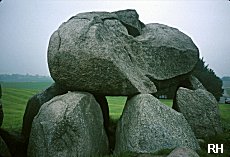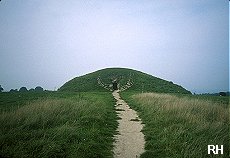insula-moenia.dk

insula-moenia.dk

This culture needed graves for their dead and it was now that Møn's first ancient monuments were build. The first peasants only used simple graves in the ground to bury their dead in, but as the society got settled they began to build barrows for their dead. The first graves were small one-man-coffins: mainly 4 base-stones with a big coverstone called barrows. These were covered with a round mound and borderstones. Long barrows, on the other hand, have a rectangular mound with borderstones around the burial chamber.
Traces of this civilization have been found on the fields at Rødkilde with 5-6 settlements.
Barrows/Cairn chambers on Møn:
Long barrows on Møn:
Later during the middle of the Neolithic Age (3300-2800 BCE), the barrows got bigger with more edges and with more space so that the society/family could use the grave for more than one burial. Most often the grave had a small passageway into the chamber. This kind of grave monument is called a passage grave.
Passage Graves on Møn
(25 known, 19 gone, 6 left):
During a period of 500 years these 3 types of big graves (102 in total) were build on Møn.
In the late Neolithic age a more common culture had rooted itself with only small local differences concerning the burial customs. This period from 2400 – 1700 BCE was named after the common use of daggers made of flintstone –"Dolktiden". Daggers and axe-blades made of bronze were also entering the country from southern countries.
About 2000 BCE a new group of people came to Møn who brought horses and herds of goats and sheep. They kept livestock, hunted, fished and grew corn. As they used battleaxes of stone, they have been called "Stridsøksekulturen" (the battle-axe culture). They buried their dead in simple graves with a small mound and even used the already existing passage graves.

